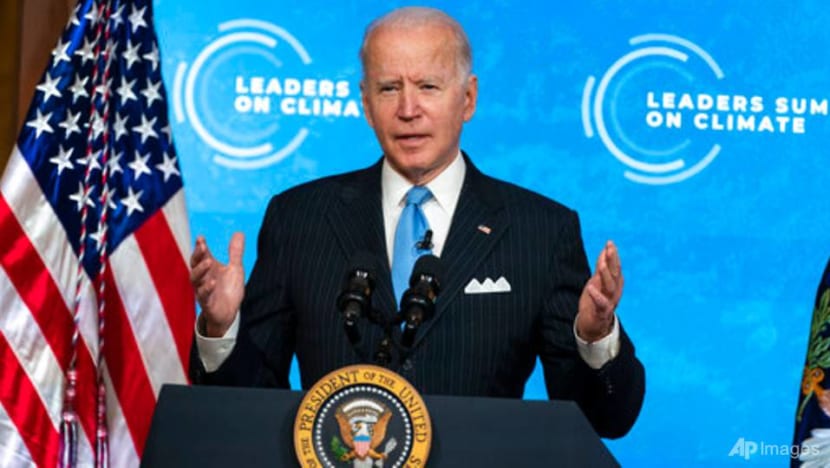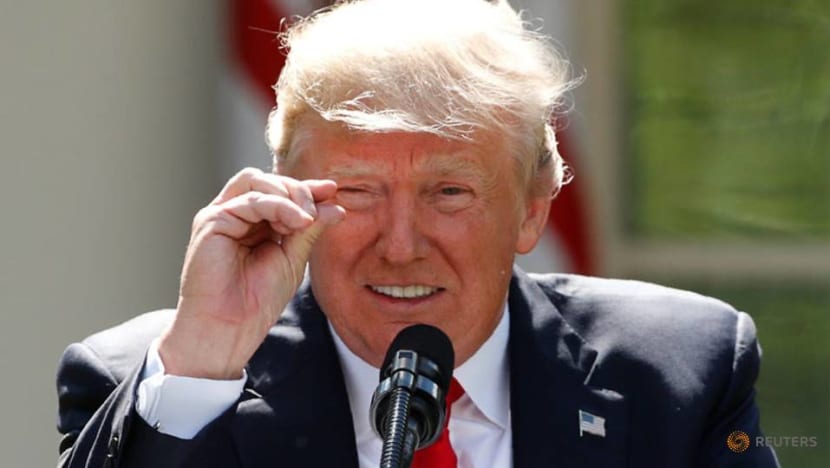commentary Commentary
Commentary: To everyone’s relief, US is back in the driver’s seat on climate change
The summit proved to the world that the Biden administration is intent on tackling climate change, says the Energy Studies Institute’s Melissa Low.

President Joe Biden speaks to the virtual Leaders Summit on Climate, from the East Room of the White House, Friday, April 23, 2021, in Washington. (AP Photo/Evan Vucci)
SINGAPORE: Last week, United States President Joe Biden hosted 40 world leaders on a live-streamed Leaders Summit on Climate to discuss the urgency of the climate crisis and paths towards stronger climate action.
The summit helped build much-needed political momentum ahead of the crucial UN climate conference scheduled to take place in Glasgow in November this year, after having been postponed by a year due to the COVID-19 pandemic.
On Earth Day, the US submitted its new climate pledge, known as a Nationally Determined Contribution (NDC) to the Paris Agreement with a commitment of 50 to 52 per cent below 2005 levels by 2030. Under the Obama administration, the US had committed to reducing emissions by 26 to 28 per cent below 2005 levels by 2025.
Climate Action Tracker (CAT) released their analysis of the new US target, noting it was a “significant step forward” and assessed it would reduce the global emissions gap by 5 to 10 per cent in 2030. Of the 52 countries that have submitted NDCs in the current round of NDC updates due in 2020 to 2021, this is the largest additional national reduction proposed to date.
READ: Commentary: Cooperation between US, China at global climate summit could yield significant benefits
The new NDC will help support President Biden’s goals to create a carbon pollution-free power sector by 2035 and net-zero emissions economy by no later than 2050. But the next steps to develop the pathways to reach these goals will be crucial.
Although the new target would result in 1.5 to 2.4 gigatonnes less of carbon dioxide equivalent emitted per year in 2030 compared to the current US emissions trajectory, CAT notes it still falls short of a target that can keep global warming within 1.5 degrees Celsius by 2030.
Yet the summit proved to the world that the Biden administration has hit the ground running and not wasted time prioritising climate change.
READ: Commentary: Joe Biden is reshaping America and the world in his image
US SERIOUS ON BEING CLIMATE LEADER
The NDC submission and summit, falling within the first 100 days of President Biden’s term in office, mark a milestone in his attempt to bridge the credibility gap created during the Trump administration.
The former administration withdrew the US from the landmark Paris Agreement adopted by 195 countries in 2015, and delivered just US$1 billion of the US$3 billion that the country pledged under the Obama administration to the UN Green Climate Fund, which was established to help vulnerable countries adapt to climate change and transition to clean energy.

On the first day of taking office, President Biden fulfilled his campaign promise and re-entered the US to the Paris Agreement.
On Jan 27, he signed an executive order to put the climate crisis at the centre of US foreign policy and national security.
President Biden has also enlisted the help of policy veterans. He appointed former Secretary of State John Kerry to lead a major diplomatic effort as his climate envoy. He tasked former Environmental Protection Agency (EPA) Administrator Gina McCarthy to put together an ambitious plan to create good-paying jobs and place the US at the forefront of clean energy innovation.
The US has shown the world that it is serious about re-establishing US leadership in international climate diplomacy. In his opening remarks, US Secretary of State Antony Blinken said that this administration plans to “do more than any other US administration has ever done” to address climate change.
READ: Commentary: Joe Biden takes office in pivotal moment for climate action. Can he deliver?
READ: Commentary: Could hydrogen be our solution to climate change?
WORLD LEADERS IN SOLIDARITY WITH THE US
World leaders grasped the opportunity presented by the summit to act in solidarity with the US. China, Japan, Korea, Brazil and Canada all signalled enhanced climate ambition by announcing new targets.
China’s President Xi Jinping said China will “strictly control” coal-fired power generation projects, and “strictly limit” increase in coal consumption until 2025, before phasing it down from 2026 to 2030.
South Korea’s President Moon Jae-In said the country will end public financing of coal-fired power plants overseas.
Japan increased its emissions reduction target from 26 per cent to 46 per cent by 2030 compared to 2013 levels, and Canada did so too, from 30 per cent to 40 to 45 per cent by 2030 compared to 2005 levels.

Brazil President Jair Bolsonaro pledged to end illegal deforestation in the country by 2030 and to achieve carbon neutrality by 2050.
One day ahead of the summit, the United Kingdom, who will host the Glasgow COP26 climate conference in November, increased its emissions reduction target to 78 per cent by 2035 from its previous target of 68 per cent by 2030.
But leaders also highlighted challenges they face in setting more ambitious targets. India’s Prime Minister Narendra Modi noted the need for developed countries to make good on their climate finance pledges, including through the Green Climate Fund.
Russian President Vladimir Putin also cited Russia’s size, geography, climate and economic structure as difficulties, but said that the country’s pledge to cut emissions up to 30 per cent below 1990 levels by 2030 was “achievable”.
READ: Commentary: China’s move on climate action signals arrival as a ‘hybrid superpower’
READ: Commentary: For China and the US, race to net-zero emissions doesn’t have to be cut-throat competition
IMMEDIATE CHALLENGES IN THE WAY OF CLIMATE ACTION
Indeed, while the summit does provide an opportunity for the US to reclaim leadership on climate, we must remember that the world is facing immediate challenges such as the COVID-19 pandemic and its economic fallout. The US alone also cannot deliver on the US$100 billion in climate finance and will require other countries to step up.
But the new US international climate finance plan should help in the meantime to build back trust as the US commits to mobilising climate finance in a “strategic and concerted way” to most efficiently tackle climate change.
This includes doubling annual public climate financing to developing countries and tripling adaptation finance by 2024.
The Biden administration will need to work with Congress and pursue domestic law and work with states and cities, civil society and the private sector to mobilise investment to meet these goals.
Singapore can play its role by supporting America’s renewed vigour in tackling climate change. As one of the 40 world leaders invited to the summit, Prime Minister Lee Hsien Loong said Singapore welcomed the signal of US leadership and commitment to climate action.

He noted that because of Singapore’s geographical size and lack of alternative energy resources, it must innovate and use technology extensively to achieve its emissions reduction goals.
Singapore can thus serve as a model for other resource-constrained countries in that respect, working alongside the US and other allies in building a sustainable future.
For many, this Leaders Summit on Climate comes as a relief, as the world continues to grapple with the evolving pandemic that dampened climate action on the road to Glasgow.
This unprecedented ambition going also marks a significant shift from the previous US administration and provides a needed boost to international climate cooperation, putting the US on track to claiming global leadership on climate action.
Listen to the author discuss what a Biden presidency will mean for international climate action:
Melissa Low is Research Fellow at the Energy Studies Institute, National University of Singapore.














